Traveling within the World
Linking your favorite traveling artists across the globe
The Grenadoe
(a.k.a. Smokepot, Grenade)
|
Tags:
Replies to This Discussion
-
Permalink Reply by Dept of PMM Artists & things on February 15, 2011 at 2:50pm
-
Flintlock Weapons
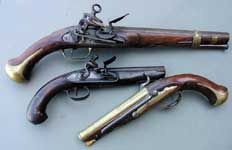 The flintlock was the dominant form of firing method for personal arms for over 200 years from the early 17th century to the early 19th century. It was simpler than the wheel lock it replaced, it produced a spark more reliably, and was much easier to make. While the basic principle remained the same, the design developed significantly over the two hundred years. Indeed the early percussion cap guns used the flintlock striking mechanism, merely replacing the frizzen and pan with a cap mount and the flint with a hammer.
The flintlock was the dominant form of firing method for personal arms for over 200 years from the early 17th century to the early 19th century. It was simpler than the wheel lock it replaced, it produced a spark more reliably, and was much easier to make. While the basic principle remained the same, the design developed significantly over the two hundred years. Indeed the early percussion cap guns used the flintlock striking mechanism, merely replacing the frizzen and pan with a cap mount and the flint with a hammer.The most important innovations are credited to the French gun maker Marin Le Bourgeoys. He replaced the separate steel and manually operated pan cover with the spring-loaded frizzen. He also introduced an intermediate position between the released and full cock positions (known as the half cock position) in which the flint was held away from the frizzen, but the trigger could not release the cock (i.e., the gun could not fire).
The Components of a Flintlock
Gun makers of the time were continually experimenting with the flintlock, adding a bit here, cutting back there, aiming to make the gun faster, more reliable and weather proof. Some of the variations involve which side of the lock plate parts are mounted. Some (particularly on expensive guns) involve sophisticated techniques to reduce friction. I will limit myself to the form as used in both the Tower musket and the Baker rifle. These use the same basic set of parts, mounted in essentially the same way, the main difference being in shape.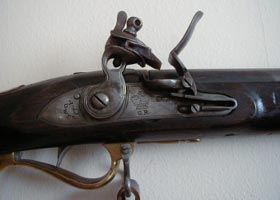

The picture on the left shows the lock plate area of an original Baker rifle of the common "flat" type. The image on the right shows the lock plate area of a replica Brown Bess musket, with additional safety features for use in modern re-enactments: a flash guard on the pan and a frizzen stall.
The Lock plate
This is the plate upon which the lock mechanism was constructed before being attached to the gun. It usually incorporated the priming pan. The rear end of the priming pan extended into a flange which contained the outer pivot hole for the frizzen. The inner pivot hole was in the main plate. In most guns the lock plate was fitted on the right hand side of the stock against the barrel, with the priming pan alongside the touchhole on the side of the barrel. All the following diagrams assume a viewpoint looking at the lock plate from the outside with the gun pointing to the right.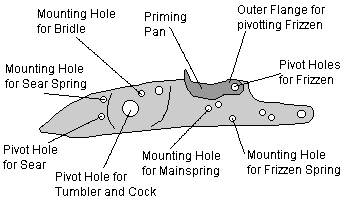
There was some regional variation as to which side of the lock plate parts were mounted. Both the Tower (Brown Bess) musket and the Baker Rifle followed the common English pattern of the time in which the following parts were mounted outside the lock plate:
The Cock is a rotating arm with the flint jaws on the outer end and a square hole at the pivot point. The rear of the flint was wrapped in a piece of leather (for grip) and clamped between the two jaws by tightening the screw. The traditional English style of cock had a graceful S-shaped arm.

The Frizzen is a combination steel (or striking plate) and priming pan cover. It is pivoted about a point in front of the priming pan on a shaft which passes through the lock plate. A cam extends down below the pivot point and a stop extends forwards from it. Pressure on the cam from the frizzen spring holds the frizzen in one of two positions: closed with the pan cover pressed over the pan; or open with the stop pressing against the frizzen spring.

The Frizzen Spring is a V-shaped spring which acts on the cam of the frizzen to either hold it closed (with the cover over the pan) or hold it open (with the stop resting against the spring).
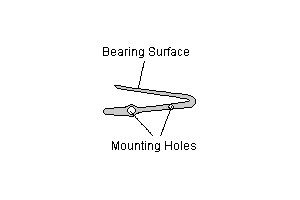

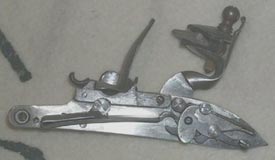
The images above show the locks of a replica Baker rifle and a replica Brown Bess musket from the inside. Both are in the half cock position and you can see the knife edge of the sear sitting well in the deep notch (or dog) of the tumbler.
The parts mounted inside the lock plate are:
The Tumbler has a shaft ending in a square spigot which passes through the lock plate to engage in the square hole in the cock so the cock and tumbler rotate together. The front of the tumbler extends forward in an upward curve, the heel, to provide a bearing surface for the main spring. The lower edge of the tumbler has three notches or dogs cut in it. The front is a deep one to prevent the tumbler rotating too far in the "fired" position and disengaging from the mainspring. The middle is also a deep one and provides the "half-cock" position. The rear is a shallow one at the "full-cock" position.

The Mainspring is a strong, V-shaped spring with a hooked end so that only the tip of the spring bears on the tumbler, reducing friction and increasing the speed of the action. The mainspring exerts a downward force on the heel, causing the cock to rotate rapidly towards the frizzen, unless the knife edge of the sear is engaged in one of the dogs in the lower edge of the tumbler.
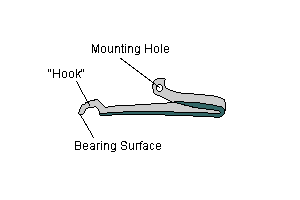
The Sear (or Scear) is a spring-loaded pawl which has a knife edge at the front to catch the notches in the tumbler. At the rear there is a bar which extends inwards (i.e., at right angles to the pawl). The trigger can operate against this bar in the full-cock position to withdraw the sear and disengage the tumbler.
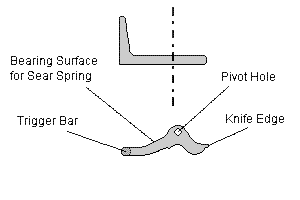
The Sear Spring is a light, V-shaped spring which presses downwards on the back of the sear (behind the pivot point) pushing the front section of the sear up against the tumbler. Pressure of the trigger on the rear bar of the sear compresses this spring and disengages (or attempts to disengage) the sear from the tumbler.

The Bridle is a flat piece of metal which holds the tumbler and sear in place. It provides the inner pivot holes for the sear and tumbler. A guard section also ensures that the sear cannot slip from under the tumbler.
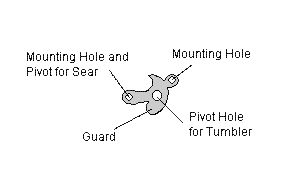
The Trigger is mounted in the stock, and has a downward extending lever for the finger to push, and a backward extending arm to engage with the bar on the sear. A spring holds the trigger in the disengaged position.
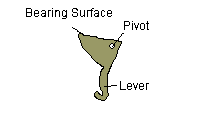
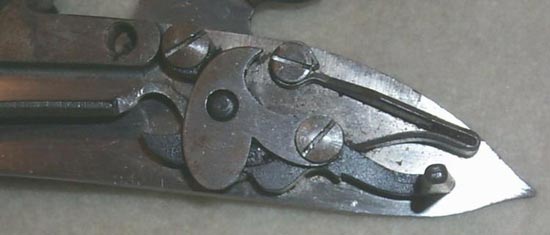
The image above is a close up view of the lock of the replica Brown Bess musket viewed from the inner side. The bridle dominates, holding the tumbler and sear in position. The end of the mainspring can be seen, pressing on the heel of the tumbler. The lock is in the half cock position, and the knife edge can be clearly seen nestled in the deep notch. The cutaway notch of the full cock position can be seen to the right of it.
-
-
Permalink Reply by Dept of PMM Artists & things on February 15, 2011 at 2:50pm
-
The Matchlock Firing
Mechanism
Matchlocks were in use from the late 1400’s until the early 1700’s, and although most had smoothbore barrels it was not unusual to find some that were made with rifled barrels. The earliest known rifled matchlock was made for Emperor Maximilian I between 1493-1508. It is also interesting to know that cloth patching was already a common practice by the early 1600’s. Around the year 1500, front and rear sights were more common, even on smoothbore guns. It is worth noting that the writings of the early American colonist of the 1600’s give more references to matchlock muskets than firelocks.
By the 1700’s, the British and French removed all the matchlocks from their forces. The shape of these early stocks may look odd, however, anyone who has ever held one can attest that these stocks hold extremely comfortably.
I have tried match cord from twisted hemp rope and found that it does in fact work much better than cotton rope. The majority of original match cord that I have tried with matchlock firearms is between 7/16" and 1/2" in diameter, both twisted and braided. Many shooters today use cotton rope soaked in salt peter, but Nathaniel Nye wrote in 1647 on making good match cord: "Take cords of hemp that’s not very fine, or of toe, which is better, although it will sooner consume, and let every cord be as big as a mans little finger, this done, boil the cords in strong lye, ashes and a little salt peter till all the lye be wasted, then dry."
-
-
Permalink Reply by Dept of PMM Artists & things on February 15, 2011 at 2:51pm
-
The Snaphance Firing
Mechanism
The Term Snaphance or Snaphaunce refers to a mechanism for igniting a firearm's propellant in a muzzle loading gun. The mechanism, which first appeared in the late 1550s, uses flint and steel to create a shower of sparks to ignite the propellant in the gun.
The flint is held in a clamp at the end of a bent lever called the cock. Upon pulling the trigger, this moves forward under the pressure of a strong spring and strikes a curved plate of hardened steel - called simply the steel, or in 17th century English dialect the frizzen - producing a shower of sparks (actually white hot steel shavings). These fall into a flash pan holding priming powder. The flash from the pan travels through the touch hole causing the main charge of gunpowder to deflagrate.
The snaphance was a development of the earlier snaplock mechanism, the main difference being the Snaphance used an automatic pan-cover (to keep the priming dry until the exact moment of firing) similar to that used in the wheel-lock, whereas the Snaplock had a manually operated pan cover similar to that of the matchlock. The Snaphance also used the lateral sear mechanism from the wheel-lock to connect trigger to cock, and later, improved models also had a variety of safety mechanisms to prevent accidental discharge of the gun.
The Snaphance was used from the late 1550s until modern times (in North African guns), but by about 1680 it was out of fashion everywhere except Northern Italy where it persisted until the 1750s. In Europe, and especially France, the Snaphance was replaced by the flintlock with its combined steel/pan cover starting from about 1620. In England, a hybrid mechanism called the English Lock replaced the Snaphance from the same date. Both the flintlock and the English lock were cheaper and less complex than the Snaphance.
The origin of the name Snaphance is thought to come from the Dutch language "Snap Haan" or German language "Schnapphahn" and has two attributions. The first is that the action of the mechanism was likened to a chicken pecking at grain (thus the name "cock" for part of the mechanism). The second attributes the use of this type of gun to chicken thieves, who would be given away by the sight and smell of a burning match if they had used the earlier matchlock gun, instead of a Snaphance in their nocturnal depredations. The German word Schnapphahn had however since moved away from the earlier definitions and has traditionally referred to a mounted highwayman, who would have been likely to use a firearm of that nature.
-
-
Permalink Reply by Dept of PMM Artists & things on February 15, 2011 at 2:51pm
-
The Wheel Lock Firing
MechanismThe Wheel Lock was the next step in firearms evolution. It is said to have been invented by Johann Kiefuss of Nuremberg in 1517, and the idea probably came from the spring driven tinder lighter in use at the time.
The idea of this mechanism is actually fairly simple - Have you ever used a modern lighter which has a flint pressed up against a roughened metal wheel? When you spin the wheel with your finger, the flint pressed against its surface throws off sparks.
 The same system was used in these firearms to create sparks as needed to ignite the gunpowder to fire the gun. No more waiting to get a wick lit, and no more stressing about it going out when the fog rolls in. In 1530, Charles V, the Holy Roman Emperor who ruled over Spain and Austria, imported the brothers Marquarte to transfer their workshops from Augsburg to Madrid. They brought to Spain unsurpassed knowledge of firearms production.
The same system was used in these firearms to create sparks as needed to ignite the gunpowder to fire the gun. No more waiting to get a wick lit, and no more stressing about it going out when the fog rolls in. In 1530, Charles V, the Holy Roman Emperor who ruled over Spain and Austria, imported the brothers Marquarte to transfer their workshops from Augsburg to Madrid. They brought to Spain unsurpassed knowledge of firearms production.The wheel lock design was eventually improved with more durable springs, their main weak point, and a cover over the wheel mechanism to protect it and keep it dry. The wheel lock was an expensive gun to make and a matchlock cost less than half as much, so it was impossible to equip a complete army with the more costly mechanism. Only a person of substantial wealth could afford one for himself.
 By around 1560 German gunsmiths were using wooden stocks and adorning them with inlays of ivory and horn. At about this time the metal parts were fire-blued to add extra beauty and to protect against corrosion. Also, metallurgy had improved to the point that gun barrels were no longer bursting very often. The strongest barrels were of damascene manufacture. In this process, strips of metal about the thickness of a man's finger are wound together. Then, another strip is wound around them for the full length of the piece, then the whole thing is heated and welded. It is hammered and forged into the final shape, then bored out. The damascene barrel was the only one that could survive being packed for its full length with gunpowder then fired. Other gun barrels were at risk with only a quarter of their length packed.
By around 1560 German gunsmiths were using wooden stocks and adorning them with inlays of ivory and horn. At about this time the metal parts were fire-blued to add extra beauty and to protect against corrosion. Also, metallurgy had improved to the point that gun barrels were no longer bursting very often. The strongest barrels were of damascene manufacture. In this process, strips of metal about the thickness of a man's finger are wound together. Then, another strip is wound around them for the full length of the piece, then the whole thing is heated and welded. It is hammered and forged into the final shape, then bored out. The damascene barrel was the only one that could survive being packed for its full length with gunpowder then fired. Other gun barrels were at risk with only a quarter of their length packed. -
Events
-
2014 is the Chinese Year of the Horse
February 17, 2026 at 12am to February 5, 2027 at 12am – where & how you choose
Birthdays
Important (read & understand)
Skype: Travelingraggyman
Email and Instant Messenger:
TravelerinBDFSM @ aol/aim; hotmail; identi.ca; live & yahoo
OR
Travelingraggyman @ gmail and icq ***

1AWARD UPDATES & INFORMATION
10,000 votes - Platinum Award
5,000 votes - Gold Award
2,500 votes - Silver Award
1,000 votes - Bronze Award
300 votes - Pewter Award
100 votes - Copper Award
Member of the Associated Posting System {APS}
This allows members on various sites to share information between sites and by providing a by line with the original source it credits the author with the creation.
Legal Disclaimer
***************We here at Traveling within the World are not responsible for anything posted by individual members. While the actions of one member do not reflect the intentions of the entire social network or the Network Creator, we do ask that you use good judgment when posting. If something is considered to be inappropriate it will be removed
Site Meter
This site is strictly an artist operational fan publication, no copyright infringement intended
Patchwork Merchant Mercenaries had its humble beginnings as an idea of a few artisans and craftsmen who enjoy performing with live steel fighting. As well as a patchwork quilt tent canvas. Most had prior military experience hence the name.
Patchwork Merchant Mercenaries.
Vendertainers that brought many things to a show and are know for helping out where ever they can.
As well as being a place where the older hand made items could be found made by them and enjoyed by all.
We expanded over the years to become well known at what we do. Now we represent over 100 artisans and craftsman that are well known in their venues and some just starting out. Some of their works have been premiered in TV, stage and movies on a regular basis.
Specializing in Medieval, Goth , Stage Film, BDFSM and Practitioner.
Patchwork Merchant Mercenaries a Dept of, Ask For IT was started by artists and former military veterans, and sword fighters, representing over 100 artisans, one who made his living traveling from fair to festival vending medieval wares. The majority of his customers are re-enactors, SCAdians and the like, looking to build their kit with period clothing, feast gear, adornments, etc.
Likewise, it is typical for these history-lovers to peruse the tent (aka mobile store front) and, upon finding something that pleases the eye, ask "Is this period?"
A deceitful query!! This is not a yes or no question. One must have a damn good understanding of European history (at least) from the fall of Rome to the mid-1600's to properly answer. Taking into account, also, the culture in which the querent is dressed is vitally important. You see, though it may be well within medieval period, it would be strange to see a Viking wearing a Caftan...or is it?
After a festival's time of answering weighty questions such as these, I'd sleep like a log! Only a mad man could possibly remember the place and time for each piece of kitchen ware, weaponry, cloth, and chain within a span of 1,000 years!! Surely there must be an easier way, a place where he could post all this knowledge...
Traveling Within The World is meant to be such a place. A place for all of these artists to keep in touch and directly interact with their fellow geeks and re-enactment hobbyists, their clientele.
© 2025 Created by Rev. Allen M. Drago ~ Traveler.
Powered by
![]()
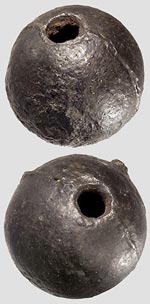 The precursor to the modern day Grenade, the Grenadoe was a round cast iron hollow ball roughly about the size of a soft ball or mature grapefruit. A hole would be be drilled to allow access to the interior, and then the sphere would be filled with gunpowder, grape shot, and other painful shrapnel.
The precursor to the modern day Grenade, the Grenadoe was a round cast iron hollow ball roughly about the size of a soft ball or mature grapefruit. A hole would be be drilled to allow access to the interior, and then the sphere would be filled with gunpowder, grape shot, and other painful shrapnel.